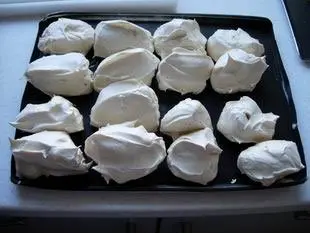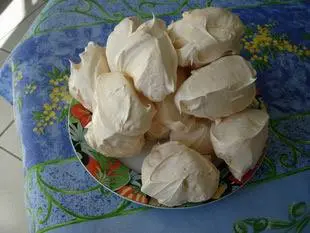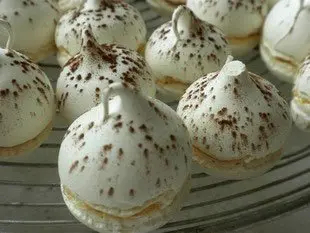The blog of cooking-ez.com
The 3 kinds of meringue
54K 22 4.5
Last modified on: June 14th 2013
The 3 kinds of meringue

But in the world of professional patisserie, meringue comes in three different kinds. Even if the principle is the same (egg whites + sugar), the results are quite distinct and lend themselves to different uses.
French meringue

This is the simplest, the easiest to make, your basic meringue. The egg whites are beaten until stiff, then caster sugar (50 g per egg white) is folded in. It's not difficult, you can let children help (they love it) and this makes very light, fluffy meringues.
Swiss meringue

The method for this is a bit different: the egg whites and caster sugar are mixed together at the start , then heated to 50°C over a bain marie before beating. This makes rather denser meringues, the sort often used to make decorative items (mushrooms, etc.) to add a finishing touch to desserts and cakes (Christmas logs, for example). If you buy meringues from a French baker, they are generally the Swiss type.
Italian meringue

Italian meringue is the most complicated: the egg whites are beaten as usual, but the sugar is cooked to the hard-ball stage (120°C) before being added to the egg whites. This makes a very smooth meringue, often used as the base for other recipes, such as nougat glacé (frozen nougat) or a pear and lime meringue pie.
To sum up
As you can see, it's all a matter of temperature (well, almost), as the basic mix of egg whites and sugar is the same. Do remember, though, that even if a particular meringue is better suited to certain recipes, in practice, you can choose whichever type suits you.
Lasts posts
Wipe meats and fish before cooking
When you want to cook meat or fish, there's a very simple yet very important step to take before you even start: It's to dry, or wipe, each side of the meat or fish, sometimes called "dabbing" or "sponging". But why? And how? Let me explain.1,8475 April 14th 2024
Toss the salad
When you've finished preparing a salad, green or otherwise, it's usually time to add the dressing and toss. It's often said to "toss the salad", which means to season and mix. Is it easy? Not so easy...3,0845 March 8th 2024
Half milk, half cream
In a multitude of recipes, savoury or sweet, milk is used as the main ingredient, or at least as the main liquid ingredient. Milk is used instead of water, for example, because milk contains a proportion of fat, which adds roundness and softness to the recipe. This mellowness is very pleasant on...2,900 February 27th 2024
Cutting soft cheeses
As you may have already noticed, when you have to use a "soft" cheese in a recipe - their exact name is "soft cheese" - such as Camembert, Munster or Mont d'or, it's not easy to make anything other than thick slices.3,0055 February 20th 2024
It's spinning too fast!
When you need to grate or slice vegetables, you generally use an electric machine that does all the work: a food processor, a mixer with a "slicer" extension or similar. Are these machines really suitable? Generally speaking, yes of course, but there's one criterion that often poses a problem,...5,9955 November 12th 2023
Other pages you may also like
What is the difference between bakery and patisserie?
This is a question that you may well have asked yourself and which I will attempt to answer. In France the two trades of "boulangerie" (bakery) and "pâtisserie" (patisserie and confectionery) have always been quite distinct, but where exactly do the boundaries lie? .119K 14.1 February 7th 2017
Candied fruits: don't get ripped off
Do you like candied fruit? You might like to nibble a handful or add it to a recipe, like a classic fruit cake or delicious Italian specialities like panettone or sicilian epiphany pie.53K 24.2 June 21th 2017
The right weight of pastry for a pie
Let's try to solve a thorny problem: How much dough will I need when I make my next pie? You're planning to make a pie, you're going to use your favourite mould or circle, but how much pastry will you need to fill it completely with a well spread pastry, without being too thin, or on the contrary...58K4.3 March 20th 2020
Steam for baking bread
What does steam have to do with bread-making? This is not only a bakers' secret, it is something you might not think of at all: if you make bread and bake it like a cake, you will end up with bread, but pale and with a thick, hard crust – a long way from the golden-brown crusty loaf you had in...136K4.5 June 16th 2021
What can I use for blind baking a pastry case?
When it comes to home-made desserts, tarts are always popular. They can be divided into two basic types: those cooked with their filling, such as an apricot and almond cream tart, and those where the filling is added after baking the pastry case, such as a strawberry tart or chocolate tart. For...104K4.5 May 2nd 2017
Follow this page (as 3 people already do)
If you are interested in this page, you can "follow" it, by entering your email address here. You will then receive a notification immediately each time the page is modified or a new comment is added. Please note that you will need to confirm this following.
Note: We'll never share your e-mail address with anyone else.
Alternatively: you can subscribe to the mailing list of cooling-ez.com , you will receive a e-mail for each new recipe published on the site.









